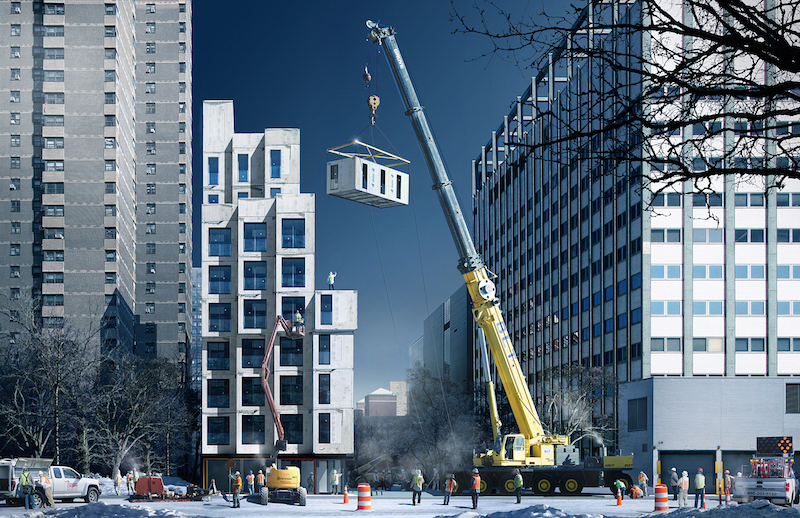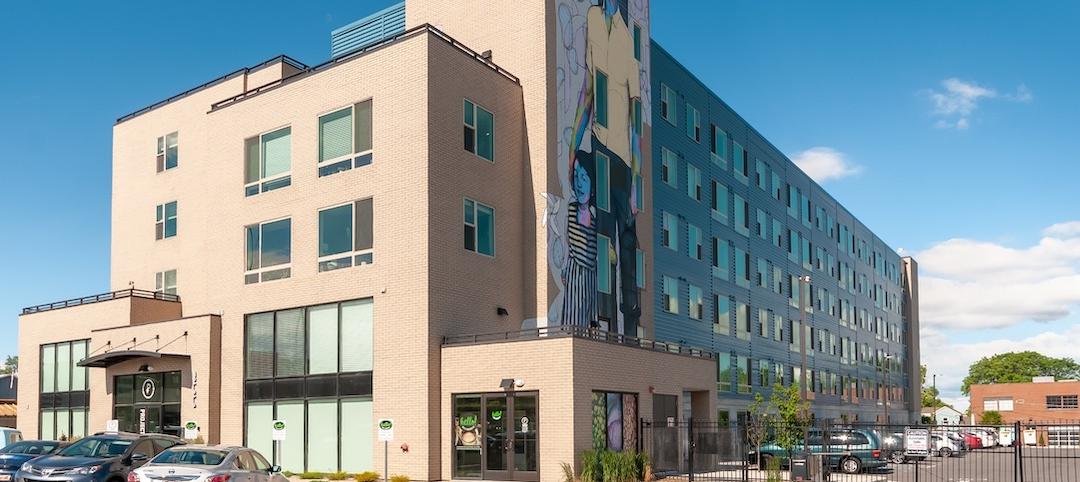Since November, Stage 3 Properties—which designs, markets, and manages rental properties in partnership with developers and investors—has been leasing Ollie at Carmel Place, a 55-unit building that is New York City’s first micro-unit multifamily development, with apartments ranging from 260 to 360 sf.
Stage 3’s “Ollie” platform offers renters the option of fully-furnished studios and shared suites, as well as access to amenities in nearby facilities that include work spaces, juice bars, pools, gyms, spas, and lounges. Ollie will even help renters find suitable roommates through its Bedvetter service.
The “all-inclusive” experience that Ollie is marketing also includes hotel-like services such as housekeeping. This week, Stage 3 announced the signing of a multiyear agreement with Hello Alfred, a personal butler and on-demand concierge service that, starting next month, renters at Carmel Place can sign up for and access through a mobile app.
Hello Alfred is a weekly subscription service that sends a background-vetted “Home Manager” to a renter’s home to take care of basic house cleaning (bed making, kitchen cleanup, etc.), laundry, dry cleaning, clothing and shoe repair, package shipping, and grocery shopping. The service starts at $32 per week.
Ollie is now Hello Alfred’s sole micro-unit partner, and charges for the services provided are already included in the quoted rents for residents.
Alfred’s CEO, Marcela Sapone, told BloombergBusiness that customers at other apartment buildings have used the service for everything from organizing receipts and meeting a cable repair person to refilling a Koi pond. If the helper isn’t able to tackle a particular job—such as plumbing or professional cleaning—he or she will find someone who can for the renter.

Monadnock Development assembled Ollie Carmel Place with factory-built modules for the micro apartments. The building in New York will be ready for renters to move into in the first quarter of 2016. Photo courtesy Monadnock Development.
Rents at Carmel Place run up to $3,150 per month, but 22 apartments are more affordably leased. “Carmel Place is a perfect fit for Ollie,” Chris Bledsoe, Stage 3’s Founding Partner, told Curbed NYC. “With 40% of the units allocated to low- and middle-income New Yorkers, the message of ‘inclusiveness’ is already an integral part of the community and the experience at the building. Additionally, the small unit sizes at Carmel Place afforded us an opportunity to demonstrate to the world that efficient units don’t inherently require a reduction in quality of life.”
Ollie at Carmel Place—which was once going to be called My Micro NY—was designed by nARCHITECTS and developed by Monadnock Development, which assembled the building from modular components. The development cost was $16.7 million.
Stage 3’s next market could be Los Angeles, according to its website. Hello Alfred currently has locations in New York, Boston, San Francisco, and L.A.
Related Stories
Multifamily Housing | Sep 12, 2019
Meet the masters of offsite construction
Prescient combines 5D software, clever engineering, and advanced robotics to create prefabricated assemblies for apartment buildings and student housing.
Multifamily Housing | Sep 10, 2019
Carbon-neutral apartment building sets the pace for scalable affordable housing
Project Open has no carbon footprint, but the six-story, solar-powered building is already leaving its imprint on Salt Lake City’s multifamily landscape.
Codes and Standards | Sep 9, 2019
Free app calculates maximum allowable heights and areas for buildings
A free app that calculates the maximum allowable heights and areas for buildings of various occupancy classifications and types of construction has been released.
Giants 400 | Aug 30, 2019
2019 K-12 School Giants Report: 360-degree learning among top school design trends for 2019
K-12 school districts are emphasizing practical, hands-on experience and personalized learning.
AEC Innovators | Aug 27, 2019
7 AEC industry disruptors and their groundbreaking achievements
From building prefab factories in the sky to incubating the next generation of AEC tech startups, our 2019 class of AEC Innovators demonstrates that the industry is poised for a shakeup. Meet BD+C’s 2019 AEC Innovators.
AEC Innovators | Aug 15, 2019
Oracle’s replica of a construction jobsite creates an immersive environment for AEC professionals
The Oracle Construction and Engineering Innovation Lab allows visitors to walk through five different stages of construction work, to test new AEC technologies and training techniques.
Museums | Jul 29, 2019
A new museum debuts inside the Empire State Building
A $165 million, 10,000-sf museum opened on the second floor of the Empire State Building in New York City, completing the second of a four-phase “reimagining” of that building’s observatory experience, which draws four million visitors annually.
Multifamily Housing | Jul 23, 2019
Is prefab in your future?
The most important benefit of offsite construction, when done right, is reliability.
Healthcare Facilities | Jul 15, 2019
Can a kids’ healthcare space teach, entertain, and heal?
Standard building requirements don’t have to be boring. Here’s how you can inject whimsical touches into everyday design features.
BD+C University Course | Jul 8, 2019
Shadow box design: To vent or not to vent [AIA course]
A curtain wall shadow box is a spandrel assembly consisting of vision glass at the building exterior and an opaque infill at the interior side of the curtain wall system. This course is worth 1.0 AIA LU/HSW.

















